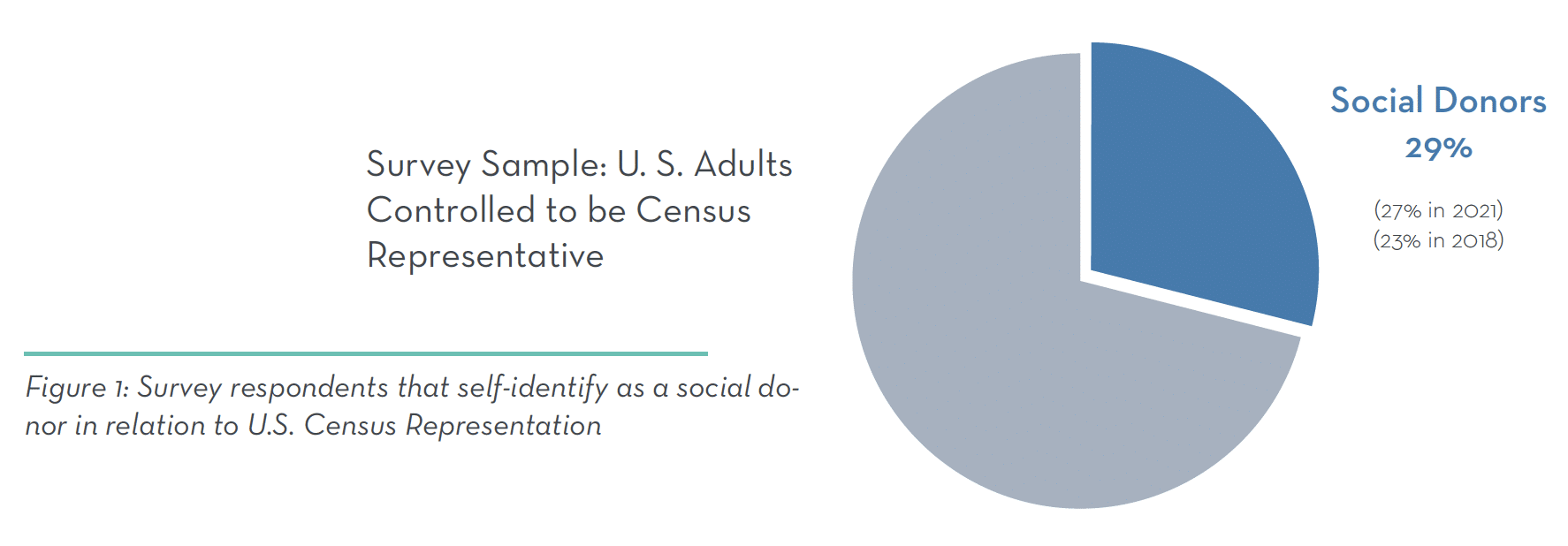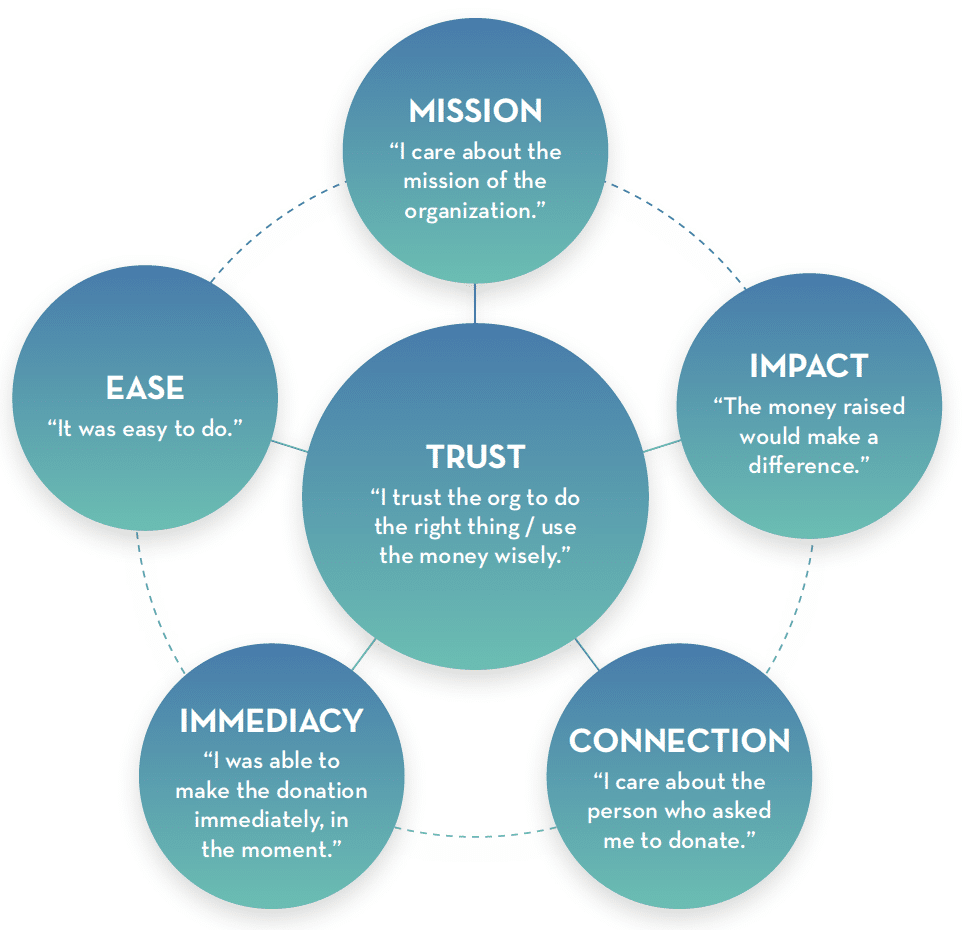4 Top Tips to Maximize Social Giving
In an increasingly competitive and crowded fundraising space, how can your nonprofit grab the attention of donors who receive multiple donation asks and event invitations? The key lies in:
- Understanding today’s social donors (trends, motivators, needs), and
- Weaving innovative strategies in your next campaigns or events.
To maximize giving in this competitive landscape, you must target one of the fastest growing giving groups: social donors. They are a growing force in philanthropy and tapping into their behavior and motivators will help you understand what makes them tick, stick, and stay.
Social donors – huh, what? Who are they? Never heard of them! Social donors are a very active subset of charitable givers who participate in socially oriented philanthropic opportunities, such as:
- Donated to or attended a fundraising event (e.g., gala or auction)
- Sponsored someone or participated in a peer-to-peer fundraiser like a walk, run, ride
- Donated or fundraised as part of a fundraising challenge, occasion, or giving day.
OneCause conducted a recent survey of 1,029 social donors who have donated to a fundraising event within the last 12 months. The purpose of the study was to dive into the giving behaviors, motivators, and expectations of social donors and how they have evolved.
According to Giving Experience Research study, this group of donors now represents approximately 30% of the U.S. Adult Giving Population. That’s 1 in 3 donors giving to events, peer-based, or challenge/giving day opportunities.
So now that we understand who they are, let’s dig into four tips your nonprofit can use to attract, engage, and optimize social giving to grow your mission this year!
1. Leverage Social Connection
As their title suggests, social donors place social connection at the center of their giving experience. More than half of social donors heard about their most recent giving opportunity through a friend, family member, or colleague. That means their social networks, workplace contacts, or family connection are an influential force to connecting them to causes and missions.
Knowing that human connections influence their giving, one way to maximize social donor engagement is to incorporate Ambassador Fundraising into your events or campaigns. Ambassador fundraising takes social fundraising to the next level by tapping into your most passionate supporters to help fundraise directly for your cause. Add a competitive element to your fundraiser, and you’ve got a sure-fire recipe for maximizing social giving!
When coming up with a list of Ambassadors, think about your:
- Board members
- Volunteers
- Sponsor connections and networks
- Event committees
- Supporters with a large social media following
Ambassadors should be people of influence who have strong networks and social clout in your community. They should be passionate about your cause, engaged in the community, and well connected!
To help your Ambassadors create serious fundraising momentum and make fundraising seamless, it’s important to arm them with templates and technology that make it easy for them to share, thank, and help them convert their networks into donors. Here are a few ideas to keep in mind:
- Sample email templates
- Promotional materials
- Social media recruitment posts
- Social integration from your peer-to-peer technology
- Donation talk tracks or donation solicitation emails
- Automated notifications when a new participant joins the campaign or their team
Remember your Ambassadors become an important “face of your cause” for your event or campaign. Helping them with tools and tech to better leverage their social networks helps amplify giving and helps your cause tap into a larger donor audience.
2. Make Fundraising Mission Focused & Transparent
With the increase in causes vying for donor attention, it can be hard to make your campaign stand out. When it comes to social donors, you must go beyond taglines and create trust with today’s givers! After all, 57% of social donors reported caring about an organization’s mission as a top motivator for giving.
Social donors are looking for a deeper connection with the causes they give too, and mission focused messaging is an easy way to build relationships. Their loyalty is also grounded in having visibility into the mission they give too and the impact that their giving creates.
Speaking of trust, it emerged as the leading motivator for today’s social donors, with 59% (approximately 6 in 10) of donors indicating it’s the most important factor when choosing to give to a nonprofit.
With such a range of motivators driving today’s donors, think of them as a generosity ecosystem. To keep these social donors giving to your cause, you need to create a giving experience that keeps trust at the forefront.
To foster trust, follow these key steps to drive deeper and more meaningful donor engagement:
- Ensure event & campaign elements connect to the ‘Why’ of your organization
- Share stories and impact examples to emphasize why your cause matters
- Be transparent on the value and use of their donations
With so many causes to engage with, social donors are looking to nonprofits for reassurance that donations are being put to good use, that organizations act with integrity, and are good stewards of their hard-earned donations. Keeping this in mind as you plan your messaging and fundraising activities will go a long way to deepen trust and connection with today’s donors.
3. Make Donating Easy
When capturing the social donor audience, especially first-time donors, an easy giving experience is essential. Fifty-eight percent of social donors decided to donate to a cause because it was easy, and they could make the donation immediately.
Be sure to evaluate your nonprofit’s donation process through the eyes of your donors prior to your next fundraising campaign.
To keep their attention and ensure the completion of their donations, nonprofits must create intuitive, fast, and flexible giving experience for their donors. Think about it – today’s donors are also today’s consumers. Who wants to do anything today that requires clunky, complex, or time-consuming process. So when you look at your giving experience, ask yourself these seven key questions:
- Is the donation button easy to locate?
- How easy is it to buy tickets or register?
- Is the giving mobile optimized? Is it easy on a phone?
- How many steps does it take from landing on the page to the gift?
- Do you have multiple payment options?
- How easy is it to get or send a donation receipt or invoice?
- Can the donor easily cover transactional costs for the nonprofit?
Here are our top recommendations to increase ease based on what our study respondents said was important in the giving experience:
Increasing Ease in the Donor Experience
| Task | % of donors found very easy | Recommendation |
|---|---|---|
| Make your donation | 83% | Make donations accessible in every touch point you make with your donors. |
| Log on | 67% | Leverage software that makes it intuitive for all donors to access easily. |
| See how close the org was to reaching its goal | 58% | Use a thermometer on your fundraiser site to visually demonstrate the progression towards your goal. |
| Register for the event | 61% | Create a seamless event entry experience through your event software – emphasize speed and security. |
| Interact with other donors | 60% | Utilize social media to help virtual and in-person donors connect with each other before, during, and after your fundraiser. |
4. Foster An Inclusive Giving Experience
Social donors are a diverse group that expands all generations and backgrounds. Now more than ever, it’s important to be intentional and inclusive with your donors.
Over the past year, half of today’s social donors gave to a cause because the event or campaign was inclusive and welcoming. To attract younger, and more diverse donors, you need to evolve your fundraising approaches and strategies to meet them where they are.
First, check out the top motivators, by generation:
Next, dig deeper and find out the demographic make-up of your supporters. Then, map their top motivators based on the chart above.
- If majority of your donors are motivated to give because of the person who asked them to donate, be sure to arm your current donors with the tools and technology to become successful fundraising ambassadors for your cause.
- If majority of your donors are motivated to give because it was easy to do, evaluate your giving experience! Identify improvements in each step of the giving process to make donated or requesting donations easier for your supporters.
- If majority of your donors are motivated to dive because they care about your mission, be sure to include mission moments throughout your donor’s journey. (Our favorite way of doing this is through video! It brings your mission to life.)
Also, offering flexible and varied participation options for your donors allows them to engage in whatever form they feel most comfortable, thus widening your reach and social donor participation.







Wrapping it Up!
Now that you know four tips to attract social donors, it’s time to make it happen! Take what you learned about social donors’ behaviors and motivators, apply them to your next fundraising campaign, and watch your fundraising grow. With these insights, your nonprofit is set to better reach, engage, and retain social donors this year!
More fundraising resources are just a click away.